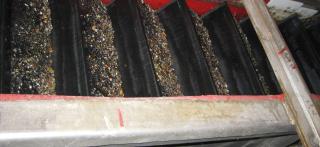
Calgary installs the largest HeadCell system in the world, reducing maintenance and operating costs
An Advanced Grit Management® system with 10 HeadCell® separators, 10 SlurryCup™ washing units, and 5 Grit Snail® dewatering escalators improved grit capture from <30% to 95%.
Situation
Calgary’s Bonnybrook wastewater treatment plant was feeling the impacts of grit from their underperforming aerated grit tanks. 20% of their digester volume was being used as grit storage and each year the plant spent 6,000 man-hours removing grit. Limited space was available for a grit system upgrade.
Problem
Calgary, Canada is situated on the confluence of the Bow and Elbow Rivers. Warm dry summers produce plenty of wind-blown dust and sand and in the severe northern prairie winters, heavy ice and snow are frequently interrupted by warm Chinook winds that sweep up from the south as the Arctic fronts temporarily retreat. The resultant rapid thaws can leave the streets awash with runoff and sand used for winter road safety.
While much of Calgary’s sewer system is sanitary sewer, significant portions of the old sewers are CSO systems. The collected wastewater leads to high concentrations of grit in the raw sewage as well as much additional grit carried in highway runoff. Bonnybrook, one of Calgary’s three wastewater treatment plants, was being upgraded to serve the City’s growing population. The new system had to be built in the limited space available and still cope with the unique characteristics of the influent wastewater.
Solution
Consulting engineering firm Stantec was hired to design the new headworks and pre-qualify the suppliers.
For the headworks project, we included maintenance costs in the lifecycle evaluation of technology options and project justification. The project scope includes screening and grit removal; screenings washing and compacting; grit classification and dewatering; solids conveyance and storage; and flow distribution and measurement," said Ryan Roberts, VP Water, Stantec, "As the removal efficiency of the existing aerated grit tanks was low, and passed on much grit to accumulate in downstream processes, a grit characterization was necessary to develop an accurate design basis for a cost-benefit evaluation of the various treatment alternatives considered.
The study found that the existing grit system was removing only 26-29% of the influent grit. It also identified the reason: virtually all of the influent grit had a settling velocity lower than a 212 µm sphere of silica sand, the conventional design point, for which the original plant was designed.
By having the grit characterization data available, Stantec was able to work with the City to determine the grit removal system performance requirements that formed part of the system specification for equipment pre-selection. A HeadCell® grit removal system was pre-selected based on its ability to remove grit particles as fine as 75 µm along with other performance and operational features, and its proven track record at other regional installations with similar performance requirements.
Outcome
The world’s largest HeadCell® grit removal, classifying and dewatering system was installed at Calgary’s Bonnybrook WWTP to reduce maintenance and operating costs. The new system is designed to treat a peak flow rate of 367 Mgal/d (1,390 ML/d).
The complete headworks process includes new 1/4" (6 mm) bar screens, screenings washer/compactors and new screenings conveyors. Each of the 10 HeadCell® units then removes and concentrates fine grit, which is pumped to a SlurryCup™ classifier unit that cleans the grit to minimize the associated organic material. Washed out organic material is returned to the treatment plant. The washed grit slurry flows by gravity to a Grit Snail® dewatering unit to produce a dewatered grit with an average of no more than 20% volatile solids by weight and greater than 60% total solids. Dewatered grit is sent to landfill. There are five Grit Snail® units, each with two SlurryCup™ units mounted on top. This configuration saves space and capital cost.

























